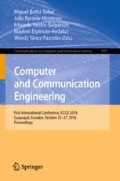Abstract
This paper introduces a model based on set theory and modern algebra that formalizes sentences and their context. The model aims at dividing sentences into cores which will be mapped into sets of an algebraic space; some of these cores have a type of context called strictly linguistic context. These sets along with an operation form Abelian groups. In addition, the model defines a function that can completely (or partially) restore the original sentence from such sets while guaranteeing its structure and meaning. This could be accomplished through queries that compare contexts and activate the task of restoring sentences. The use case scenario has been limited to the Spanish language. All these processes can be applied in many scenarios, but our focus lies in the dynamic creation of small theories.
Access this chapter
Tax calculation will be finalised at checkout
Purchases are for personal use only
Notes
- 1.
We would like to express our appreciation to Duvań Cardona Sańchez for his support in the mathematical area.
- 2.
The VISL parser, from the University of Southern Denmark was used in this work under the permission of this institution.
References
Kecskes, I.: The paradox of communications. Socio-cognitive approach to pragmatics. Inf. Control., 52–55 (2010)
Tulving, E.: Episodic and semantic memory. In: Tulving, E., Donaldson, W. (eds.) Organization of Memory, pp. 381–403. Academic Press, New York (1972)
Havel, I.M.: Strategies of Remembrance: From Pindar to Hölderlin, chap. 2. Cambridge Scholars (2009)
Conway, M., Pleydell-Pearce, C.: The construction of autobiographical memories in the self memory system. Psychol. Rev. 107(2), 261–288 (2000)
Bazire, M., Brézillon, P.: Understanding Context before using it. In: Dey, A., Kokinov, B., Leake, D., Turner, R. (eds.) CONTEXT 2005. LNCS (LNAI), vol. 3554, pp. 29–40. Springer, Heidelberg (2005). https://doi.org/10.1007/11508373_3
Buvac, S., Mason, I.A.: Propositional logic of context. In: AAAI, pp. 412–419 (1993)
McCarthy, J.: Notes on formalizing context. In: Proceedings of the 13th International Joint Conference on Artifical Intelligence, San Francisco, CA, USA, pp. 555–560 (1993)
Guha, R.: Contexts: a formalization and some applications (1992)
Ghidini, C., Giunchiglia, F.: Local models semantics, or contextual reasoning=locality+compatibility. Artif. Intell. 127(2), 221–259 (2001). https://doi.org/10.1016/S0004-3702(01)00064-9
Haase, P., et al.: D3.1.1 context languages - state of the art. Technical report D3.1.1, Universität Karlsruhe (TH) (2006)
Costanza, P., Hirschfeld, R.: Language constructs for context-oriented programming: an overview of contextl. In: Proceedings of the 2005 Symposium on Dynamic Languages, New York, NY, USA, pp. 1–10 (2005)
Salvaneschi, G., Ghezzi, C., Pradella, M.: Context-oriented programming: A software engineering perspective. J. Syst. Softw. 85(8), 1801–1817 (2012). https://doi.org/10.1016/j.jss.2012.03.024
Luna Traill, E., Vigueras Avila, A., Baez Pinal, G.E.: Diccionario básico de lingüística. UNAM (2005)
Vivaldi, G.M., Sánchez, A.: Curso de Redacción. Thomson Eds, Paraninfo S.A. (2000)
Gruber, T.R.: Toward principles for the design of ontologies used for knowledge sharing. Int. J. Hum. Comput. Stud. 43(5–6), 907–928 (1995). https://doi.org/10.1006/ijhc.1995.1081
Cimiano, P., Völker, J.: Text2onto - a framework for ontology learning and data-driven change discovery. In: Proceedings of the 10th International Conference on Applications of Natural Language to Information Systems (NLDB), Alicante, Spain, pp. 227–238 (2005)
Velardi, P., Faralli, S., Navigli, R.: Ontolearn reloaded: a graph-based algorithm for taxonomy induction. Comput. Linguist. 39(3), 665–707 (2013). http://dblp.uni-trier.de/db/journals/coling/coling39.html#VelardiFN13
Lenat, D.B., Guha, R.V.: Building Large Knowledge-Based Systems; Representation and Inference in the Cyc Project. Addison-Wesley Longman Publishing Co., Inc., Boston (1989)
Arroyo Cantón, C., Berlato Rodríguez, P.: La comunicación. Lengua castellana y Literatura. Oxford University Press, España (2012)
Montealegre, R.: La comprension del texto: Sentido y significado. Revista Latinoamericana de Psicología. Universidad Nacional de Colombia 36(2), 243–255 (2004)
González Calvo, J.M.: Los conceptos de proposición, oración y enunciado. La frase nominal. Liceus Servicios de Gestión y Comunicación S.L (2006)
Bick, E.: A constraint grammar-based parser for spanish. In: TIL (2006)
Boeree, G.: Basic language structures (2017). http://webspace.ship.edu/cgboer/basiclangstruct.html
Author information
Authors and Affiliations
Corresponding authors
Editor information
Editors and Affiliations
Rights and permissions
Copyright information
© 2019 Springer Nature Switzerland AG
About this paper
Cite this paper
Barraza Verdesoto, E.S., Rivas Trujillo, E., Medina García, V.H. (2019). Algebraic Model to Formalize the Sentences and Their Context for Texts Written in the Spanish Language. In: Botto-Tobar, M., Barzola-Monteses, J., Santos-Baquerizo, E., Espinoza-Andaluz, M., Yánez-Pazmiño, W. (eds) Computer and Communication Engineering. ICCCE 2018. Communications in Computer and Information Science, vol 959. Springer, Cham. https://doi.org/10.1007/978-3-030-12018-4_6
Download citation
DOI: https://doi.org/10.1007/978-3-030-12018-4_6
Published:
Publisher Name: Springer, Cham
Print ISBN: 978-3-030-12017-7
Online ISBN: 978-3-030-12018-4
eBook Packages: Computer ScienceComputer Science (R0)

